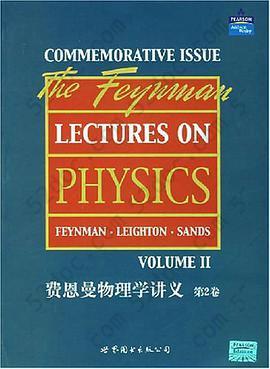注重体验与质量的电子书资源下载网站
分类于: 人工智能 计算机基础
简介

费恩曼物理学讲义(第2卷)(英文版): 第二卷·英文版 豆 9.3分
资源最后更新于 2020-09-21 15:59:46
作者:Richard P. Feynman
出版社:世界图书出版公司
出版日期:2004-01
ISBN:9787506272483
文件格式: pdf
标签: 物理 费曼 物理学 Physics 英文原版 科学 教材 feynman
简介· · · · · ·
《费恩曼物理学讲义》(第2卷)讲述当时美国大学物理教学改革试图解决的一个主要问题是基础物理教学应尽可能反映近代物理的巨大成就。《费恩曼物理学讲义》在基础物理的水平上对20世纪物理学的两大重要成就——相对论和量子力学——作了系统的介绍,对于量子力学,费恩曼教授还特地准备了一套适合大学二年级水平的讲法。教学改革试图解决的另一个问题是按照当前物理学工作者在各个前沿研究领域所使用的方式来介绍物理学的内容。在《费恩曼物理学讲义》一书中对一些问题的分析和处理方法反映了费恩曼自己以及其他在前沿研究领域工作的物理学家所通常采用的分析和处理方法。全书对基本概念、定理和定律的讲解不仅生动清晰,通俗易懂,而且特别注重从物理上作出深刻的叙述。为了扩大学生的知识面,全书还列举了许多基本物理原理在各个方面(诸如天体物理、地球物理、生物物理等)的应用,以及物理学的一些最新成就。由...
目录
chapter 1. electromagnetism .
1-1 electrical forces 1-1
1-2 electric and magnetic felds 1-3
1-3 characteristics of vector fields 1-4
1-4 the laws of electromagnetism i-5
i-5 what are the fields? 1-9
1-6 electromagnetism in science and technology 1-10
chapter 2. differential calculus of vector fields
2-1 understanding physics 2-1
2-2 scalar and vector fields—t and h 2-2
2-3 derivatives of fields—the gradient 2-4
2-4 the operator v 2-6
2-5 operations with v 2-7
2-6 the differential equation of heat flow 2-8
2-7 second derivatives of vector fields 2-9
2-8 pitfalls 2-11
chapter 3. vector integral calculus
3-1 vector integrals; the line integral of v,it 3-1
3-2 the flux of a vector field 3-2
3-3 the flux from a cube; gauss' theorem 3-4
.3-4 heat conduction; the diffusion equation 3-6
3-5 the circulation of a vector field 3-8
3-6 the circulation around a square;
stokes' theorem 3-9
3-7 curl-free and divergence-free fields 3-10
3-8 summary 3-11
chapter 4. electrostatics
4-1 statics 4—1
4-2 coulomb's law; superposition 4-2
4-3 electric potential 4-4
4-4 e=- φ 4-6
4-5 the flux of e 4-7
4-6 gauss' law; divergence of e 4-9
4-7 field of a sphere of charge 4-10
4-8 field lines; equipotential surfaces 4-1l
chapter 5. application of gauss' law
5-1 electrostatics is gauss's law plus . . . 5-1
5-2 equilibrium in an electrostatic field 5-1
5-3 equilibrium with conductors 5-2
5-4 stability of atoms 5-3
5-5 the field of a line charge 5-3
5-6 a sheet of charge; two sheets 5-4
5-7 a sphere of charge; a spherical shell 5-4
5-8 is the field of a point charge exactly 1/r2? 5-5
5-9 the fields of a conductor 5-7
5-10 the field in a cavity of a conductor 5-8
chapter 6. the electric field in various
circumstances
6-1 equations of the electrostatic potential 6-1
6-2 the electric dipole 6-2
6-3 remarks on vector equations 6-4
6-4 the dipole potential as a gradient 6-4
6-5 the dipole approximation for an arbitrary
distribution 6-6
6-6 the fields of charged conductors 6-8
6-7 the method of images 6-8
6-8 a point charge near a conducting plane 6-9
6-9 a point charge near a conducting sphere 6-10
6-10 condensers; parallel plates 6-11
6-11 high-voltage breakdown 6-13
6-12 the field-emission microscope 6-14
chapter 7. the electric field in various
circumstances (continued)
7-1 methods for finding the electrostatic field 7-1
7-2 two-dimensional fields; functions of the complex
variable 7-2
7-3 plasma oscillations 7-5
7—4 colloidal particles in an electrolyte 7-8
7-5 the electrostatic field of a grid 7-10
chapter 8. electrostatic energy
8-1 the electrostatic energy of charges. a uniform
sphere 8-t
8-2 the energy of a condenser. forces on charged
conductors 8-2
8-3 the electrostatic energy of an ionic crystal 8-4
8-4 electrostatic energy in nuclei 8-6
8-5 energy in the electrostatic field 8-9
8-6 the energy of a point charge 8-12
chapter 9. electricity in the atmosphere
9-1 the electric potential gradient of the
atmosphere 9-1
9-2 electric currents in the atmosphere 9-2
9-3 origin of the atmospheric currents 9-4
9-4 thunderstorms 9-5
9-5 the mechanism of charge separation 9-7
9-6 lightning 9-10
chapter 10. dielectrics
10-1 the dielectric constant 10-1
10—2 the polarization vector p 10-2
10-3 polarization charges 10-3
10-4 the electrostatic equations with dielectrics 10-6
10-5 fields and forces with dielectrics 10-7
chapter 11. inside dielectrics
11-1 molecular dipoles 11-1
11-2 electronic polarization 11-1
11-3 polar molecules; orientation polarization 11-3
11-4 electric fields in cavities of a dielectric 11-5
11-5 the dielectric constant of liquids; the clausius-
mossotti equation 11-6
11-6 solid dielectrics 11-8
11-7 ferroelectricity; batioa 11-8
chapter 12. electrostatic analogs
12-1 the same equations have the same solutions 12-1
12-2 the flow of heat; a point source near an infinite
plane boundary 12-2
12-3 the stretched membrane 12-5
12-4 the diffusion of neutrons; a uniform spherical
source in a homogeneous medium 12-6
12-5 irrotational fluid flow; the flow past a sphere 12-8
12-6 illumination; the uniform lighting of a plane 12-10
12-7 the "underlying unity" of nature 12-12
chapter 13. magnetostatics
13-1 the magnetic field 13-1
13-2 electric current; the conservation of charge 13-1
13-3 the magnetic force on a current 13-2
13-4 the magnetic field of steady currents;
ampere's law 13-3
13-5 the magnetic field of a straight wire and of a
solenoid; atomic currents 13-5
13-6 the relativity of magnetic and electric fields 13-6
13-7 the transformation of currents and charges 13-11
13-8 superposition; the right-hand rule 13-11
chapter 14. the magnetic field in various
situations
14-1 the vector potential 14-1
14-2 the vector potential of known currents 14-3
14-3 a straight wire 14-4
14-4 a long solenoid 14-5
14-5 the field of a small loop; the magnetic dipole 14-7
14-6 the vector potential of a circuit 14-8
14-7 the law of blot and savart 14-9
chapter 15. the vector potential
15-1 the forces on a current loop; energy of
a dipole 15-1
15-2 mechanical and electrical energies 15-3
15-3 the energy of steady currents 15-6
15-4 b versus a 15-7
15-5 the vector potential and quantum mechanics 15-8
15-6 what is true for statics is false for dynamics 15-14
chapter 16. induced currents
16-1 motors and generators 16-1
16-2 transformers and inductances 16-4
16-3 forces on induced currents 16-5
16-4 electrical technology 16-8
chapter 17. the laws of induction
17-1 the physics of induction 17-1
17-2 exceptions to the "flux rule" 17-2
17-3 particle acceleration by an induced electric field;
the betatron 17-3
17-4 a paradox 17-5
17-5 alternating-current generator 17-6
17-6 mutual inductance 17-9
17-7 self-inductance 17-11
17-8 inductance and magnetic energy 17-12
chapter 18. the maxwell equations
18-1 maxwell's equations 18-1
18-2 how the new term works 18-3
18-3 all of classical physics 18-5
18-4 a travelling field 18-5
18-5 the speed of light 18-8
18-6 solving maxwell's equations; the potentials and the
wave equation 18-9
chapter 19. the principle of least action
a special lecture—almost verbatim 19-1
a note added after the lecture 19-14
chapter 20. solutions of maxwell's equations
in free space
20-1 waves in free space; plane waves 20-1
20-2 three-dimensional waves 20-8
20-3 scientific imagination 20-9
20-4 spherical waves 20—12
chapter 21. solutions of maxwell's equations ..
with currents and charges
21-1 light and electromagnetic waves 21-1
21-2 spherical waves from a point source 21-2
21-3 the general solution of maxwell's equations 21-4
21-4 the fields of an oscillating dipole 21-5
21-5 the potentials of a moving charge; the general
solution of lienard and wiechert 21-9
21-6 the potentials for a charge moving with constant
velocity; the lorentz formula 21-12
chapter 22. ac circuits
22-1 impedances 22-1
22-2 generators 22-5
22-3 networks of ideal elements; kirchhoff's rules 22-7
22-4 equivalent circuits 22-10
22-5 energy 22-11
22-6 a ladder network 22-12
22-7 filters 22-14
22-8 other circuit elements 22-16
chapter 23. cavity resonators
23-1 real circuit elements 23-1
23-2 a capacitor at high frequencies 23-2
23-3 a resonant cavity 23-6
23-4 cavity modes 23-9
23-5 cavities and resonant circuits 23-10
chapter 24. waveguides
24-1 the transmission line 24-1
24-2 the rectangular waveguide 24-4
24-3 the cutoff frequency 24-6
24-4 the speed of the guided waves 24-7
24-5 observing guided waves 24-7
24-6 waveguide plumbing 24-8
24-7 waveguide modes 24-10
24-8 another way of looking at the guided waves 24-10
chapter 25. electrodynamics in relativistic
notation
25-1 four-vectors 25-1
25-2 the scalar product 25-3
25-3 the four-dimensional gradient 25-6
25-4 electrodynamics in four-dimensional notation 25-8
25-5 the four-potential of a moving charge 25-9
25-6 the invariance of the equations of
electrodynamics 25-10
chapter 26. lorentz transformations of the fields
26-1 the four-potential of a moving charge 26-1
26-2 the fields of a point charge with a constant
velocity 26-2
26-3 relativistic transformation of the fields 26-5
26-4 the equations of motion in relativistic
notation 26-11
chapter 27. field energy and field momentum
27-1 local conservation 27-1
27-2 energy conservation and electromagnetism 27-2
27-3 energy density and energy flow in the
electromagnetic field 27-3
27-4 the ambiguity of the field energy 27-6
27-5 examples of energy flow 27-6
27-6 field momentum 27-9
chapter 28. electromagnetic mass
28-1 the field energy of a point charge 28-1
28-2 the field momentum of a moving charge 28-2
28-3 electromagnetic moss 28-3
28-4 the force of an electron on itself 28-4
28-5 attempts to modify the maxwell theory 28-6
28-6 the nuclear force field 28-12
chapter 29. the motion of charges in electric
and magnetic fields
29-1 motion in a uniform electric or magnetic field 29-1
29-2 momentum analysis 29-1
29-3 an electrostatic lens 29-2
29-4 a magnetic lens 29-3
29-5 the electron microscope 29-3
29-6 accelerator guide fields 29-4
29-7 alternating-gradient focusing 29-6
29-8 motion in crossed electric and magnetic fields 29-8
chapter 30. the internal geometry of crystals
30-1 the internal geometry of crystals 30-1
30-2 chemical bonds in crystals 30-2
30-3 the growth of crystals 30-3
30-4 crystal lattices 30-3
30-5 symmetries in two dimensions 30-4
30-6 symmetries in three dimensions 30-7
30-7 the strength of metals 30-8
30-8 dislocations and crystal growth 30-9
30-9 the bragg-nye crystal model 30-10
chapter 31. tensors
31-1 the tensor of polarizability 31-1
31-2 transforming the tensor components 31-3
31-3 the energy ellipsoid 3 i-3
31-4 other tensors; the tensor of inertia 31-6
31-5 the cross product 31-8
31-6 the tensor of stress 31-9
31-7 tensors of higher rank 31-11
31-8 the four-tensor of electromagnetic
momentum 31-12
chapter 32. refractive index of dense materials
32-1 polarization of matter 32-1
32-2 maxwell's equations in a dielectric 32-3
32-3 waves in a dielectric 32-5
32-4 the complex index of refraction 32-8
32-5 the index of a mixture 32-8
32-6 waves in metals 32-10
32-7 low-frequency and high-frequency approximations;
the skin depth and the plasma frequency 32-11
chapter 33. reflection from surfaces
33-1 reflection and refraction of light 33-1
33-2 waves in dense materials 33-2
33-3 the boundary conditions 33-4
33-4 the reflected and transmitted waves 33-7
33-5 reflection from metals 33-11
33-6 total internal reflection 33-12
chapter 34. the magnetism of matter
34-1 diamagnetism and paramagnetism 34-1
34-2 magnetic moments and angular momentum 34-3
34-3 the precession of atomic magnets 34-4
34-4 diamagnetism 34-5
34-5 larmor's theorem 34-6
34-6 classical physics gives neither diamagnetism nor
paramagnetism 34-8
34-7 angular momentum in quantum mechanics 34-8
34-8 the magnetic energy of atoms 34-11
chapter 35. paramagnetism and magnetic resonance
35-1 quantized magnetic states 35-1
35-2 the stern-gerlach experiment 35-3
35-3 the rabi molecular-beam method 35-4
35-4 the paramagnetism of bulk materials 35-6
35-5 cooling by adiabatic demagnetization 35-9
35-6 nuclear magnetic resonance 35-10
chapter 36. ferromagnetism
36-1 magnetization currents 36-1
36-2 the field h'36-5
36-3 the magnetization curve 36-6
36-4 iron-core inductances 36-8
36-5 electromagnets 36-9
36-6 spontaneous magnetization 36-11
chapter 37. magnetic materials
37-1 understanding ferromagnetism 37-1
37-2 thermodynamic properties 37-4
37-3 the hysteresis curve 37-5
37-4 ferromagnetic materials 37-10
37-5 extraordinary magnetic materials 37-11
chapter 38. elasticity
38-1 hooke's law 38-1
38-2 uniform strains 38-2
38-3 the torsion bar; shear waves 38-5
38-4 the bent beam 38-9
38-5 buckling 38-i1
chapter 39. elastic materials
39-1 the tensor of strain 39-1
39-2 the tensor of elasticity 39-4
39-3 the motions in an elastic body 39-6
39-4 nonelastic behavior 39-8
39-5 calculating the elastic constants 39-10
chapter 40. the flow of dry water
40-1 hydrostatics 40-1
40-2 the equations of motion 40-2
40-3 steady fiow—bernoulli's theorem 40-6
40-4 circulation 40-9
40-5 vortex lines 40-10
chapter 41. the flow of wet water
41-1 viscosity 41-1
41-2 viscous flow 41-4
41-3 the reynolds number 41-5
4l-4 flow past a circular cylinder 41-7
41-5 the limit of zero viscosity 41-9
41-6 couette flow 41-10
chapter 42. curven space
42-1 curved spaces with two dimensions 42-1
42-2 curvature in three-dimensional space 42-5
42-3 our space is curved 42-6
42-4 geometry in space-time 42-7
42-5 gravity and the principle of equivalence 42-8
42-6 the speed of clocks in a gravitational field 42-9
42-7 the curvature of space-time 42-11
42-8 motion in curved space-time 42-12
42-9 einstein's theory of gravitation 42-13
1-1 electrical forces 1-1
1-2 electric and magnetic felds 1-3
1-3 characteristics of vector fields 1-4
1-4 the laws of electromagnetism i-5
i-5 what are the fields? 1-9
1-6 electromagnetism in science and technology 1-10
chapter 2. differential calculus of vector fields
2-1 understanding physics 2-1
2-2 scalar and vector fields—t and h 2-2
2-3 derivatives of fields—the gradient 2-4
2-4 the operator v 2-6
2-5 operations with v 2-7
2-6 the differential equation of heat flow 2-8
2-7 second derivatives of vector fields 2-9
2-8 pitfalls 2-11
chapter 3. vector integral calculus
3-1 vector integrals; the line integral of v,it 3-1
3-2 the flux of a vector field 3-2
3-3 the flux from a cube; gauss' theorem 3-4
.3-4 heat conduction; the diffusion equation 3-6
3-5 the circulation of a vector field 3-8
3-6 the circulation around a square;
stokes' theorem 3-9
3-7 curl-free and divergence-free fields 3-10
3-8 summary 3-11
chapter 4. electrostatics
4-1 statics 4—1
4-2 coulomb's law; superposition 4-2
4-3 electric potential 4-4
4-4 e=- φ 4-6
4-5 the flux of e 4-7
4-6 gauss' law; divergence of e 4-9
4-7 field of a sphere of charge 4-10
4-8 field lines; equipotential surfaces 4-1l
chapter 5. application of gauss' law
5-1 electrostatics is gauss's law plus . . . 5-1
5-2 equilibrium in an electrostatic field 5-1
5-3 equilibrium with conductors 5-2
5-4 stability of atoms 5-3
5-5 the field of a line charge 5-3
5-6 a sheet of charge; two sheets 5-4
5-7 a sphere of charge; a spherical shell 5-4
5-8 is the field of a point charge exactly 1/r2? 5-5
5-9 the fields of a conductor 5-7
5-10 the field in a cavity of a conductor 5-8
chapter 6. the electric field in various
circumstances
6-1 equations of the electrostatic potential 6-1
6-2 the electric dipole 6-2
6-3 remarks on vector equations 6-4
6-4 the dipole potential as a gradient 6-4
6-5 the dipole approximation for an arbitrary
distribution 6-6
6-6 the fields of charged conductors 6-8
6-7 the method of images 6-8
6-8 a point charge near a conducting plane 6-9
6-9 a point charge near a conducting sphere 6-10
6-10 condensers; parallel plates 6-11
6-11 high-voltage breakdown 6-13
6-12 the field-emission microscope 6-14
chapter 7. the electric field in various
circumstances (continued)
7-1 methods for finding the electrostatic field 7-1
7-2 two-dimensional fields; functions of the complex
variable 7-2
7-3 plasma oscillations 7-5
7—4 colloidal particles in an electrolyte 7-8
7-5 the electrostatic field of a grid 7-10
chapter 8. electrostatic energy
8-1 the electrostatic energy of charges. a uniform
sphere 8-t
8-2 the energy of a condenser. forces on charged
conductors 8-2
8-3 the electrostatic energy of an ionic crystal 8-4
8-4 electrostatic energy in nuclei 8-6
8-5 energy in the electrostatic field 8-9
8-6 the energy of a point charge 8-12
chapter 9. electricity in the atmosphere
9-1 the electric potential gradient of the
atmosphere 9-1
9-2 electric currents in the atmosphere 9-2
9-3 origin of the atmospheric currents 9-4
9-4 thunderstorms 9-5
9-5 the mechanism of charge separation 9-7
9-6 lightning 9-10
chapter 10. dielectrics
10-1 the dielectric constant 10-1
10—2 the polarization vector p 10-2
10-3 polarization charges 10-3
10-4 the electrostatic equations with dielectrics 10-6
10-5 fields and forces with dielectrics 10-7
chapter 11. inside dielectrics
11-1 molecular dipoles 11-1
11-2 electronic polarization 11-1
11-3 polar molecules; orientation polarization 11-3
11-4 electric fields in cavities of a dielectric 11-5
11-5 the dielectric constant of liquids; the clausius-
mossotti equation 11-6
11-6 solid dielectrics 11-8
11-7 ferroelectricity; batioa 11-8
chapter 12. electrostatic analogs
12-1 the same equations have the same solutions 12-1
12-2 the flow of heat; a point source near an infinite
plane boundary 12-2
12-3 the stretched membrane 12-5
12-4 the diffusion of neutrons; a uniform spherical
source in a homogeneous medium 12-6
12-5 irrotational fluid flow; the flow past a sphere 12-8
12-6 illumination; the uniform lighting of a plane 12-10
12-7 the "underlying unity" of nature 12-12
chapter 13. magnetostatics
13-1 the magnetic field 13-1
13-2 electric current; the conservation of charge 13-1
13-3 the magnetic force on a current 13-2
13-4 the magnetic field of steady currents;
ampere's law 13-3
13-5 the magnetic field of a straight wire and of a
solenoid; atomic currents 13-5
13-6 the relativity of magnetic and electric fields 13-6
13-7 the transformation of currents and charges 13-11
13-8 superposition; the right-hand rule 13-11
chapter 14. the magnetic field in various
situations
14-1 the vector potential 14-1
14-2 the vector potential of known currents 14-3
14-3 a straight wire 14-4
14-4 a long solenoid 14-5
14-5 the field of a small loop; the magnetic dipole 14-7
14-6 the vector potential of a circuit 14-8
14-7 the law of blot and savart 14-9
chapter 15. the vector potential
15-1 the forces on a current loop; energy of
a dipole 15-1
15-2 mechanical and electrical energies 15-3
15-3 the energy of steady currents 15-6
15-4 b versus a 15-7
15-5 the vector potential and quantum mechanics 15-8
15-6 what is true for statics is false for dynamics 15-14
chapter 16. induced currents
16-1 motors and generators 16-1
16-2 transformers and inductances 16-4
16-3 forces on induced currents 16-5
16-4 electrical technology 16-8
chapter 17. the laws of induction
17-1 the physics of induction 17-1
17-2 exceptions to the "flux rule" 17-2
17-3 particle acceleration by an induced electric field;
the betatron 17-3
17-4 a paradox 17-5
17-5 alternating-current generator 17-6
17-6 mutual inductance 17-9
17-7 self-inductance 17-11
17-8 inductance and magnetic energy 17-12
chapter 18. the maxwell equations
18-1 maxwell's equations 18-1
18-2 how the new term works 18-3
18-3 all of classical physics 18-5
18-4 a travelling field 18-5
18-5 the speed of light 18-8
18-6 solving maxwell's equations; the potentials and the
wave equation 18-9
chapter 19. the principle of least action
a special lecture—almost verbatim 19-1
a note added after the lecture 19-14
chapter 20. solutions of maxwell's equations
in free space
20-1 waves in free space; plane waves 20-1
20-2 three-dimensional waves 20-8
20-3 scientific imagination 20-9
20-4 spherical waves 20—12
chapter 21. solutions of maxwell's equations ..
with currents and charges
21-1 light and electromagnetic waves 21-1
21-2 spherical waves from a point source 21-2
21-3 the general solution of maxwell's equations 21-4
21-4 the fields of an oscillating dipole 21-5
21-5 the potentials of a moving charge; the general
solution of lienard and wiechert 21-9
21-6 the potentials for a charge moving with constant
velocity; the lorentz formula 21-12
chapter 22. ac circuits
22-1 impedances 22-1
22-2 generators 22-5
22-3 networks of ideal elements; kirchhoff's rules 22-7
22-4 equivalent circuits 22-10
22-5 energy 22-11
22-6 a ladder network 22-12
22-7 filters 22-14
22-8 other circuit elements 22-16
chapter 23. cavity resonators
23-1 real circuit elements 23-1
23-2 a capacitor at high frequencies 23-2
23-3 a resonant cavity 23-6
23-4 cavity modes 23-9
23-5 cavities and resonant circuits 23-10
chapter 24. waveguides
24-1 the transmission line 24-1
24-2 the rectangular waveguide 24-4
24-3 the cutoff frequency 24-6
24-4 the speed of the guided waves 24-7
24-5 observing guided waves 24-7
24-6 waveguide plumbing 24-8
24-7 waveguide modes 24-10
24-8 another way of looking at the guided waves 24-10
chapter 25. electrodynamics in relativistic
notation
25-1 four-vectors 25-1
25-2 the scalar product 25-3
25-3 the four-dimensional gradient 25-6
25-4 electrodynamics in four-dimensional notation 25-8
25-5 the four-potential of a moving charge 25-9
25-6 the invariance of the equations of
electrodynamics 25-10
chapter 26. lorentz transformations of the fields
26-1 the four-potential of a moving charge 26-1
26-2 the fields of a point charge with a constant
velocity 26-2
26-3 relativistic transformation of the fields 26-5
26-4 the equations of motion in relativistic
notation 26-11
chapter 27. field energy and field momentum
27-1 local conservation 27-1
27-2 energy conservation and electromagnetism 27-2
27-3 energy density and energy flow in the
electromagnetic field 27-3
27-4 the ambiguity of the field energy 27-6
27-5 examples of energy flow 27-6
27-6 field momentum 27-9
chapter 28. electromagnetic mass
28-1 the field energy of a point charge 28-1
28-2 the field momentum of a moving charge 28-2
28-3 electromagnetic moss 28-3
28-4 the force of an electron on itself 28-4
28-5 attempts to modify the maxwell theory 28-6
28-6 the nuclear force field 28-12
chapter 29. the motion of charges in electric
and magnetic fields
29-1 motion in a uniform electric or magnetic field 29-1
29-2 momentum analysis 29-1
29-3 an electrostatic lens 29-2
29-4 a magnetic lens 29-3
29-5 the electron microscope 29-3
29-6 accelerator guide fields 29-4
29-7 alternating-gradient focusing 29-6
29-8 motion in crossed electric and magnetic fields 29-8
chapter 30. the internal geometry of crystals
30-1 the internal geometry of crystals 30-1
30-2 chemical bonds in crystals 30-2
30-3 the growth of crystals 30-3
30-4 crystal lattices 30-3
30-5 symmetries in two dimensions 30-4
30-6 symmetries in three dimensions 30-7
30-7 the strength of metals 30-8
30-8 dislocations and crystal growth 30-9
30-9 the bragg-nye crystal model 30-10
chapter 31. tensors
31-1 the tensor of polarizability 31-1
31-2 transforming the tensor components 31-3
31-3 the energy ellipsoid 3 i-3
31-4 other tensors; the tensor of inertia 31-6
31-5 the cross product 31-8
31-6 the tensor of stress 31-9
31-7 tensors of higher rank 31-11
31-8 the four-tensor of electromagnetic
momentum 31-12
chapter 32. refractive index of dense materials
32-1 polarization of matter 32-1
32-2 maxwell's equations in a dielectric 32-3
32-3 waves in a dielectric 32-5
32-4 the complex index of refraction 32-8
32-5 the index of a mixture 32-8
32-6 waves in metals 32-10
32-7 low-frequency and high-frequency approximations;
the skin depth and the plasma frequency 32-11
chapter 33. reflection from surfaces
33-1 reflection and refraction of light 33-1
33-2 waves in dense materials 33-2
33-3 the boundary conditions 33-4
33-4 the reflected and transmitted waves 33-7
33-5 reflection from metals 33-11
33-6 total internal reflection 33-12
chapter 34. the magnetism of matter
34-1 diamagnetism and paramagnetism 34-1
34-2 magnetic moments and angular momentum 34-3
34-3 the precession of atomic magnets 34-4
34-4 diamagnetism 34-5
34-5 larmor's theorem 34-6
34-6 classical physics gives neither diamagnetism nor
paramagnetism 34-8
34-7 angular momentum in quantum mechanics 34-8
34-8 the magnetic energy of atoms 34-11
chapter 35. paramagnetism and magnetic resonance
35-1 quantized magnetic states 35-1
35-2 the stern-gerlach experiment 35-3
35-3 the rabi molecular-beam method 35-4
35-4 the paramagnetism of bulk materials 35-6
35-5 cooling by adiabatic demagnetization 35-9
35-6 nuclear magnetic resonance 35-10
chapter 36. ferromagnetism
36-1 magnetization currents 36-1
36-2 the field h'36-5
36-3 the magnetization curve 36-6
36-4 iron-core inductances 36-8
36-5 electromagnets 36-9
36-6 spontaneous magnetization 36-11
chapter 37. magnetic materials
37-1 understanding ferromagnetism 37-1
37-2 thermodynamic properties 37-4
37-3 the hysteresis curve 37-5
37-4 ferromagnetic materials 37-10
37-5 extraordinary magnetic materials 37-11
chapter 38. elasticity
38-1 hooke's law 38-1
38-2 uniform strains 38-2
38-3 the torsion bar; shear waves 38-5
38-4 the bent beam 38-9
38-5 buckling 38-i1
chapter 39. elastic materials
39-1 the tensor of strain 39-1
39-2 the tensor of elasticity 39-4
39-3 the motions in an elastic body 39-6
39-4 nonelastic behavior 39-8
39-5 calculating the elastic constants 39-10
chapter 40. the flow of dry water
40-1 hydrostatics 40-1
40-2 the equations of motion 40-2
40-3 steady fiow—bernoulli's theorem 40-6
40-4 circulation 40-9
40-5 vortex lines 40-10
chapter 41. the flow of wet water
41-1 viscosity 41-1
41-2 viscous flow 41-4
41-3 the reynolds number 41-5
4l-4 flow past a circular cylinder 41-7
41-5 the limit of zero viscosity 41-9
41-6 couette flow 41-10
chapter 42. curven space
42-1 curved spaces with two dimensions 42-1
42-2 curvature in three-dimensional space 42-5
42-3 our space is curved 42-6
42-4 geometry in space-time 42-7
42-5 gravity and the principle of equivalence 42-8
42-6 the speed of clocks in a gravitational field 42-9
42-7 the curvature of space-time 42-11
42-8 motion in curved space-time 42-12
42-9 einstein's theory of gravitation 42-13








